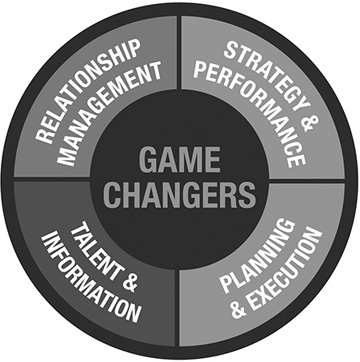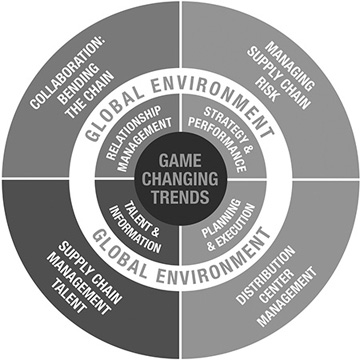Introduction to the Supply Chain Game Changers: Applications and Best Practices that are Shaping the Future of Supply Chain Management
At the University of Tennessee, we do a great deal of research on leading-edge supply chain concepts that run the gamut from future supply chain megatrends to logistics operations. One publication even ranked us number one in the world for supply chain academic research output.1
We have learned much about modern supply chains and even more about how to manage them. But after numerous conversations with industry partners, we concluded that we needed to do a better job reaching the practitioner community. We were not adequately communicating our findings to the supply chain professionals who were doing the real work, or to the leaders who were struggling with the daily challenges of supply chain operations.
Supply chain professionals are very busy people. They are continuously engulfed in a maelstrom of events ranging from angry customers to damaged shipments, and they all must be addressed immediately. They know they need to keep developing professionally, but have precious little time to do so—and even less time to read documents written by academics, for academics. What we had to do as supply chain researchers, then, was publicize our game-changing findings as accessible, highly substantive material.
In 2012, we launched the Supply Chain Game Changers series of white papers to do just that. We have written six of these white papers thus far, with topics ranging from global supply chain management to distribution-center best practices. These papers have enjoyed great success in the professional community, so we thought it was time to put a bow around that work and publish it in a book that supply chain professionals could use as a single reference on a variety of topics that we will describe later in this introduction. Each white paper represents a chapter in this book. As the series of white papers continues to grow, we will periodically publish additional sets of workbooks for the many dedicated practitioners of supply chain management.
One of the fundamental concepts of this book is that of game-changing trends in supply chain management. These trends are significantly impacting how leaders shape their supply chains today. Our research allowed us to group these trends into four major areas as shown in Figure 1.

Figure 1 GSCI SC game changers model
The six topics in this book fit nicely into this framework. In Figure 2, you can see the first topic, “Game-Changing Trends,” at the core of the diagram. The “Global Supply Chains” topic is next in an inner circle touching all of the subjects. Then the four remaining chapters reside on the outside: “Managing Risk in the Supply Chain,” “Collaboration: Bending the Chain,” “Supply Chain Talent Management,” and “Distribution-Center Management.”

Figure 2 GSCI SC game changers model link to this book
Chapter 1 starts at the core, with a description of 10 game-changing trends in supply chain management. Fresh ideas about game-changing trends arise constantly and are highly dynamic. In this chapter, we define game-changing trends as those trends that are extremely impactful on a firm’s economic profit and shareholder value while also being very difficult to successfully address. In addition, we included an addendum that takes a long look ahead and considers how these trends may play out by 2025.
Our interactions with hundreds of companies helped us develop this list of 10 game-changers. Not only do we identify the supply chain trends that you will face in modern industry, but also we provide recommendations for how to make progress toward desired end states. We also use plenty of real-world examples along the way to make these concepts more applicable to typical business practice.
Chapter 1 also includes an addendum. While the changes occurring in supply chain thought and practice during the first 15 years of the 21st century were significant, many experts predict that even more substantial change will occur over the next decade. In fact, the supply chain world of 2025 promises to look very different from the one today. This addendum extrapolates on the state of the original 10 game-changing trends in order to predict the evolution of supply chain management over the coming decade. In addition, it identifies five new trends that are likely to be influential in driving the changing supply chain between 2015 and 2025.
Chapter 2 then moves to the topic that arguably encompasses all of the others: the global supply chain environment. Most firms have global suppliers and/or global customers. Supply chain professionals know that they somehow need to manage this complex worldwide network in order to provide better service to customers while simultaneously delivering lower costs and inventory levels.
In this chapter, we provide a series of best-practice recommendations to help meet these daunting challenges. These are based on the EPIC (economy, politics, infrastructure, and competence) framework from the recent book, Global Supply Chains: Evaluating Regions on an EPIC Framework.2 In this chapter, we also break down the best practices for supply chain network design in the global environment, as well as best practices for managing complex global supply chains. Chapter 2 is intended to provide valuable tools for supply chain leaders to design and manage a winning global supply chain.
Chapter 3 explores risk in the global supply chain. Over the last decade, many companies have faced extreme supply chain challenges that have stretched their capabilities to the breaking point. Both the preponderance of natural disasters and huge economic swings have caused challenges across the supply chain. These challenges are certainly not going away.
Supply chains, which once functioned almost on autopilot, face many dangers today in both global and domestic markets. Due to its global nature and systemic impact on the firm’s financial performance, the supply chain arguably faces more risk than other areas of the company. Risk is a fact of life for any supply chain, whether it is dealing with quality and safety challenges, supply shortages, legal issues, security problems, regulatory and environmental compliance, weather and natural disasters, or terrorism. This chapter discusses best practices for identifying, prioritizing, and mitigating risk.
Chapter 4 explores warehouse management best practices, a topic we refer to as the “ABCs of DCs.” We felt that it was important to have a topic in this book dealing with supply chain and logistics execution. Logistics professionals who operate distribution centers (DCs) have a tough job. Management constantly challenges these leaders to cut cost, which basically means doing more with less. With cost cutting as their primary focus, they also need to make sure that customer responsiveness does not suffer, and in fact improves. This calls for a highly advanced management skill set. Chapter 4 covers a wide range of DC management best practices, from picking/receiving to people to sustainability.
Chapter 5 delves into the very challenging field of cross-functional integration. In the supply chain audits that we have conducted over the years, we do many interviews with managers and executives—more than 800 in the past 5 years alone. We always end each interview with a “wish list” question. What topped these wish lists most often was the desire for all functions in a company to work together toward and align perfectly for a common purpose. It is no exaggeration to say that the professionals we interview pine for an environment where the functional silo walls have come down. They intuitively know that these disconnects are the real reasons things are not improving faster.
Chapter 5 specifically focuses on one of the greatest potential threats to integration. Ironically, the biggest threat can be found between two interactions traditionally thought of as belonging to the supply chain function: the interaction between purchasing and manufacturing, and the interaction between manufacturing and logistics. Our research suggests that a major gap often exists between purchasing and logistics, resulting in the destruction of value. This lends credence to the infamous quote, “We have met the enemy and he is us!” Chapter 5 discusses the best practices for bridging these divides.
Chapter 6 takes a deep dive into talent in the global supply chain. Ten to fifteen years ago, the supply chain leader in most companies held the Vice President of Logistics title. This was a largely functional role that relied on technical proficiency in discrete areas: knowledge of shipping routes, understanding of warehousing equipment, familiarity with distribution-center locations and footprints, and a solid grasp of freight rates and fuel costs. The Vice President of Logistics reported to the Chief Operating Officer or Chief Financial Officer, had few prospects of advancing further, and had no exposure to the executive committee.
Thanks to game-changing global trends, the way companies need to think of the modern supply chain executive has changed dramatically. In Chapter 6, we describe the professional skills leading supply chain professionals need today, as well as the best practices for managing talent. In doing so, we introduce a five-stage framework of talent management:
- Analyze needs
- Find talent
- Recruit talent
- Develop talent
- Retain talent
The conclusion to the book takes all of this material and synthesizes it. We identified the top 10 actions that we strongly believe you need to take to create a world-class supply chain. In fact, we included a self-evaluation tool to help you assess exactly where you stand today. This chapter is intended to bring it all together for you, and help you prepare an action plan to change your supply chain game.
We hope that you enjoy the journey through this supply chain game-changing material. You might want to jump around, going first to the topics in which you have the most interest. We have compiled this book in a way that allows you to do just that. Or you may find it more useful to read from beginning to end, in the order we agreed was most logical. However you use this book, we hope you will gain insights along the way that can truly transform your supply chain.